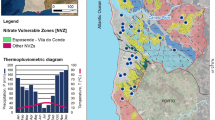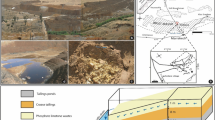Abstract
The study on the migration behaviour of light non-aqueous phase liquid (LNAPL) through the subsurface system is essential for implementing a proper remedial measure against groundwater contamination. A FEM-based flow and transport model FEFLOW (Finite Element subsurface FLOW and transport system) was utilised in this study to model the migration of LNAPL, through the unsaturated zone, where the LNAPL is modelled as a single-phase contaminant with the least water solubility. Further, it evaluates the utility of a natural fibre, coir geotextile (CG) in controlling the migration of the LNAPL through the subsurface system based on an experimental study. The predictions from the numerical model are compared and found matching with the experimental results. The CG layer is also modelled similarly to the soil layer with appropriate values of the parameters, which defines the novelty of this study. Hence, the developed numerical model is used to simulate the actual field conditions to assess how long the coir geotextile can sustain as a remedial measure for controlling LNAPL migration through the soil. The provision of two layers of CG with a vertical layer on both sides as a box-like containment could hold LNAPL up to 7.5 years in the wet condition and 5 years in the dry condition of soil.
Similar content being viewed by others
Abbreviations
- C :
-
solute concentration (kg/m3)
- D :
-
dispersion coefficient (m2/s)
- D d :
-
molecular diffusion (m2/s)
- e :
-
gravitational unit vector
- f μ :
-
function of fluid viscosity
- g :
-
gravitational acceleration (m/s2)
- h :
-
capillary head (m)
- I :
-
unit tensor
- K :
-
hydraulic conductivity tensor (m2)
- K r :
-
relative hydraulic conductivity
- k :
-
intrinsic permeability tensor (m2)
- n, m :
-
van Genuchten parameters
- p f :
-
fluid pressure (N/m2)
- Q :
-
specific mass supply
- q :
-
darcy flux vector (m/s)
- R :
-
soil retardation coefficient
- s :
-
saturation
- s f :
-
fluid saturation
- S e :
-
effective saturation
- S o :
-
storage coefficient (m−1)
- t :
-
time (s)
- z :
-
elevation above a reference datum (m)
- Δ:
-
differential operator
- ρ :
-
density (kg/m3)
- ε :
-
porosity
- χ :
-
adsorption function
- Ψ :
-
pressure head (m)
- θ :
-
volumetric water content
- ϑ:
-
decay rate
References
Ali, N., El-Harbawi, M., Jabal, A. A., Yin, C. Y. 2012. Characteristics and oil sorption effectiveness of kapok fibre, sugarcane bagasse and rice husks: Oil removal suitability matrix. Environ Technol, 33: 481–486.
Al-Majed, A. A., Adebayo, A. R., Hossain, M. E. 2012. A sustainable approach to controlling oil spills. J Environ Manage, 113: 213–227.
Benson, D. A. 1994. User’s manual to VENT2D: A multi-compound vapor transport and phase distribution model. Claremont Streat: Reno, NV, USA.
Berlin, M., Vasudevan, M., Kumar, G. S., Nambi, I. M. 2015. Numerical modelling of fate and transport of petroleum hydrocarbons in an unsaturated subsurface system for varying source scenario. J Earth Syst Sci, 124: 655–674.
Clement, T. P. 1999. A modular computer code for simulating reactive multi-species transport in 3-dimensional groundwater systems. Report No. 11720. Pacific Northwest National Laboratory, Richland, WA, USA.
Clough, S. R. 2014. Heptane. In: Encyclopedia of Toxicology (2nd edn). Wexler, P. Ed. Elsevier, 845–847
Corapcioglu, M. Y., Baehr, A. 1985. Immiscible contaminant transport in soils and groundwater with an emphasis on petroleum hydrocarbons: System of differential equations vs single cell model. Water Sci Technol, 17: 23–37.
Diersch, H. J. G. 2005. About the formulation of hydraulic head boundary (potential) conditions for fluid density-dependent groundwater problems. In: FEFLOW—White Papers Vol. I. Berlin: WASY, 133–138.
EPA. 2004. EPA 402-R-99-004A. Understanding variation in partition coefficient, Kd, values. Environmental Protection Agency (EPA), Washington, D. C., USA.
Fagerlund, F., Niemi, A. 2007. A partially coupled, fraction-by-fraction modelling approach to the subsurface migration of gasoline spills. J Contam Hydrol, 89: 174–198.
Fityus, S. G., Smith, D. W., Booker, J. R. 1999. Contaminant transport through an unsaturated soil liner beneath a landfill. Can Geotech J, 36: 330–354.
Gidigasu, M. 2012. Laterite Soil Engineering: Pedogenesis and Engineering Principles. Netherlands: Elsevier.
Gigliuto, A., Righetti, C., Cuzzola, A., Belfanti, P. 2015. Groundwater flow finite element model in a costal aquifer to evaluate remediation strategies. In: Proceedings of the FEFLOW 2015 Conference.
Guarnaccia, J., Pinder, G., Fishman, M. 1997. NAPL: Simulator documentation. National Risk Management Research Laboratory, U.S. Environmental Protection Agency, Research and Development, USA.
Huyakorn, P. S., Wu, Y. S., Panday, S. 1992. A comprehensive three-dimensional numerical model for predicting the transport and fate of petroleum hydrocarbons in the subsurface. In: Proceedings of the Conference on Petroleum Hydrocarbons and Organic Chemicals in Groundwater: Prevention, Detection, and Restoration, Houston, TX, USA.
Illangasekare, T. H., Armbruster, E. J., Yates, D. N. 1995. Non-aqueous-phase fluids in heterogeneous aquifers—Experimental study. J Env Eng, 121: 571–579.
Kaluarachchi, J. J., Parker, J. C., Lenhard, R. J. 1990. A numerical model for areal migration of water and light hydrocarbon in unconfined aquifers. Adv Water Resour Res, 13: 29–40.
Kamaruddin, S. A., Sulaiman, W. N. A., Rahman, N. A., Zakaria, M. P., Mustaffar, M., Sa’ari, R. 2011. A review of laboratory and numerical simulations of hydrocarbons migration in subsurface environments. J Env Sci Tech, 4: 191–214.
Karana, C. P., Rengasamy, R. S., Das, D. 2011. Oil spill cleanup by structured fibre assembly. Indian J Fibre Text, 36: 190–200.
Katyal, A. K., Kaluarachchi, J. J., Parker, J. C. 1991. MOFAT: A two-dimensional finite-element program for multiphase flow and multicomponent transport. Program documentation and user’s guide. Technical Report No. PB-91-191692/XAB. Virginia Polytechnic Institue and State University, Blacksburg, VA, USA.
Mosavati, B., Mosavati, M., Kowsary, F. 2013. Solution of radiative inverse boundary design problem in a combined radiating-free convecting furnace. Int Commun Heat Mass Transf, 45: 130–136.
Mosavati, B., Mosavati, M., Kowsary, F. 2016. Inverse boundary design solution in a combined radiating-free convecting furnace filled with participating medium containing specularly reflecting walls. Int Commun Heat Mass Transf, 76: 69–76.
Panday, S., Huyakorn, P. S. 2008. MODFLOW SURFACT: A state-of-the-art use of vadose zone flow and transport equations and numerical techniques for environmental evaluations. Vadose Zone J, 7: 610–631.
Patil, S. B., Chore, H. S. 2014. Contaminant transport through porous media: An overview of experimental and numerical studies. Adv Env Res, 3: 45–69.
Praseeja, A. V., Sajikumar, N. 2019. A review on the study of immiscible fluid flow in unsaturated porous media: Modeling and remediation. J Porous Media, 22: 889–922.
Praseeja, A. V., Sajikumar, N. 2020. LNAPL migration in vadoze zone and its prevention using natural fiber. J Nat Fibers, https://doi.org/10.1080/15440478.2020.1848701.
Praseeja, A. V., Sajikumar, N. 2021. Experimental investigation of coir fibre on its potential for the sorption of hydrocarbons. In: Advances in Civil Engineering. Singh, R. M., Sudheer, K. P., Kurian, B. Eds. Singapore: Springer, 75–89.
Pruess, K., Oldenburg, C. M., Moridis, G. J. 1999. TOUGH2 user’s guide version 2 (No. LBNL-43134). Lawrence Berkeley National Laboratory, Berkeley, CA, USA.
Sinton, P., Wingle, B., Bartlett, D. 2015. FEFLOW model of a copper mine, Arizona, USA. In: Proceedings of the FEFLOW 2015 Conference.
Stroo, H. F., Unger, M., Ward, C. H., Kavanaugh, M. C., Vogel, C., Leeson, A., Marqusee, J., Smith, B. P. 2003. Remediating chlorinated solvent source zones. Environ Sci Tech, 37: 224A–230A.
Sulaymon, A. H., Gzar, H. A. 2011. Experimental investigation and numerical modeling of light nonaqueous phase liquid dissolution and transport in a saturated zone of the soil. J Hazard Mater, 186: 1601–1614.
Van Geel, P. J., Sykes, J. F. 1994a. Laboratory and model simulations of a LNAPL spill in a variably-saturated sand, 1. Laboratory experiment and image analysis techniques. J Contam Hydrol, 17: 1–25.
Van Geel, P. J., Sykes, J. F. 1994b. Laboratory and model simulations of a LNAPL spill in a variably-saturated sand, 2. Comparison of laboratory and model results. J Contam Hydrol, 17: 27–53.
Vigouroux, R., Lenhardt, F., Doucet, N., Boisson, M. 2015. Design of a passive hydraulic containment system using FEFLOW modeling. In: Proceedings of the FEFLOW 2015 Conference.
White, M. D., Oostrom, M., Lenhard, R. J. 1995. Modeling fluid flow and transport in variably saturated porous media with the STOMP simulator. 1. Nonvolatile three-phase model description. Adv Water Resour, 18: 353–364.
Author information
Authors and Affiliations
Corresponding author
Ethics declarations
The authors declare that they have no conflict of interest.
Rights and permissions
About this article
Cite this article
Praseeja, A.V., Sajikumar, N. Numerical simulation on LNAPL migration in vadose zone and its prevention using natural fibre. Exp. Comput. Multiph. Flow 5, 53–66 (2023). https://doi.org/10.1007/s42757-021-0120-8
Received:
Revised:
Accepted:
Published:
Issue Date:
DOI: https://doi.org/10.1007/s42757-021-0120-8




